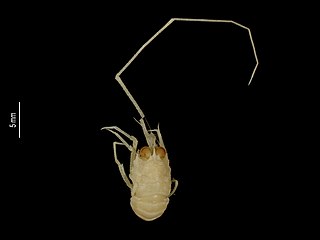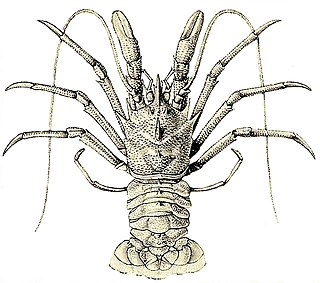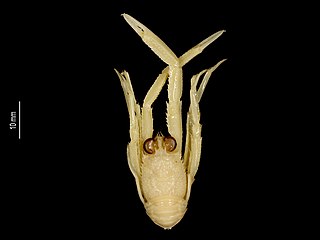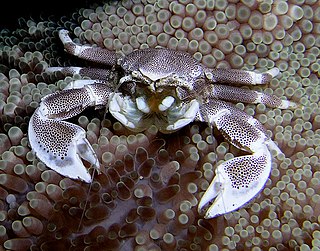Munidopsis andamanica is a species of squat lobster that lives in the deep sea and eats dead wood. It has long chelipeds, which are twice as long as the carapace.

Munidopsis serricornis is a species of squat lobster. It is widely distributed in the world's oceans, being found in the eastern Atlantic Ocean, the western Atlantic Ocean, and the Indo-Pacific. It grows up to a carapace length of 20 millimetres (0.8 in).

Munidopsis is a genus of squat lobster. It is the second largest of all the genera of squat lobsters, after Munida, with over 200 species. Its members are mainly found on continental slopes and on abyssal plains. A few fossil species are also known, including specimens from the Campanian (Cretaceous).
Anomoeomunida is a monotypic squat lobster genus in the family Munididae. The sole a species of is Anomoeomunida caribensis. It occurs in the western Atlantic.

Anoplonida is a genus of squat lobsters, which are flattened dorsoventrally, in the family Munididae, containing the following species:

Bathymunida is a genus of squat lobsters in the family Munididae, containing the following species:

Crosnierita is a genus of squat lobsters in the family Munididae, containing the following species:
Enriquea leviantennata is a species of squat lobster in a monotypic genus in the family Munididae.

Galacantha is a genus of squat lobsters in the family Munidopsidae, containing the following species:

Heteronida is a genus of squat lobsters in the family Munididae. They occur in the western Pacific Ocean.

Neonida grandis is a species of squat lobster in a monotypic genus in the family Munididae.

Onconida is a genus of squat lobsters in the family Munididae, containing the following species:

Plesionida is a genus of squat lobsters in the family Munididae. As of 2017, it contains the following species:

Raymunida is a genus of squat lobsters in the family Munididae, containing the following 11 species:
Setanida cristata is a species of squat lobster in a monotypic genus in the family Munididae.

Shinkaia crosnieri is a species of squat lobster in a monotypic genus in the family Munidopsidae. S. crosnieri lives in deep-sea hydrothermal vent ecosystems, living off of the chemosynthetic activity of certain bacteria living on its setae.
Tasmanida norfolkae is a species of squat lobster in a monotypic genus in the family Munididae.

The Galatheoidea are a superfamily of decapod crustaceans comprising the porcelain crabs and some squat lobsters. Squat lobsters within the three families of the superfamily Chirostyloidea are not closely related to the squat lobsters within the Galatheoidea. The fossil record of the superfamily extends back to the Middle Jurassic genus Palaeomunidopsis.
Munidopsis echinata is a species of squat lobster, first found in deep waters off Taiwan. M. echinata is similar to M. colombiana, but differs by lacking an antennal spine on its carapace and having a rather longer antennal peduncle.
Munidopsis tafrii is a species of squat lobster first found in Taiwanese waters at depths greater than 3,000 metres (9,800 ft). It resembles M. ceratophthalma, however its carapace morphology distinguishes it from its cogenerate species.











